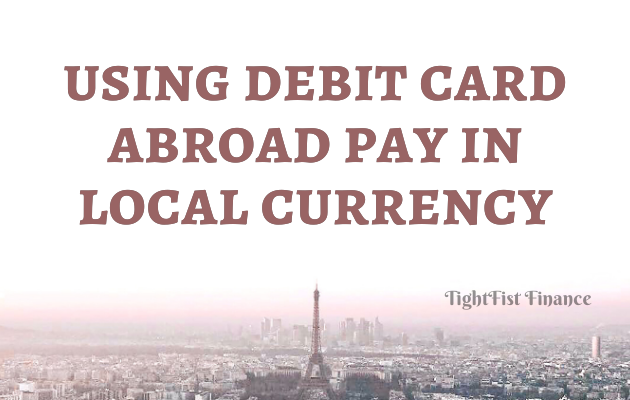What do you need to know about using a debit card abroad to pay in local currency?
In most cases, it is cheaper, faster, and provides less confusion to pay in local currency when traveling abroad. Most notably, paying in local currency saves you from currency conversion fees. You can select the option to pay in local currency at the point of sales system.
You’re on vacation in the Mexican Riviera or catching the sights and sounds of Paris, France. The last thing you want to do is pay more for meals and souvenirs while on your trip. But using a debit card abroad can present some challenges.
One of them is paying in local currency or U.S. dollars. While you can do either, it’s best to pay in local currency.
After you swipe or enter your debit card, you should always have the choice of paying in local currency. If you do not see this option, ask the merchant to void the sale and start over. Let’s look at some reasons choosing local currency is to your advantage.

This article may contain affiliate links which pay a commission and supports this blog. Thank you for your support!
Using a Debit Card to Pay in Local Currency
You can use a U.S. debit card to pay for goods and services in another country’s currency. All you have to do is present your card and choose the local currency option. Retail and restaurant staff should either ask you, or a POS system should give you a choice.
There is nothing else you need to do. Your card issuer will convert the local currency to U.S. dollars behind the scenes. The bank or card issuer will then deduct the amount in USD.
Reasons to Choose to Pay in Local Currency
Here are the main reasons you’ll want to choose local currency rather than USD conversion options while traveling abroad.
1. Lower Costs
Converting to U.S. dollars at the point of sale can cost you, literally. You’ll often pay a premium to convert foreign transactions to U.S. dollars. Instead of a 1% or 2% difference, you might pay as much as 12%.
This is because card issuers have more cost-effective agreements and negotiation ability. You’ll get a more favorable exchange rate when the conversion happens after the fact. Otherwise, you are subject to whatever exchange rate markups businesses charge.
2. Streamlined Charges
Let’s say you’re on a grand tour that spans multiple countries. This won’t be as much of an issue in the European Union, where businesses accept a single currency. However, cruises and other trips where you visit different countries can get hairy.
By always choosing to pay in the local currency, you’ll leverage the current value of the U.S. dollar. You also won’t be paying higher conversion fees with one merchant and lower transaction costs at another. Your card issuer can streamline exchange rates and charges.
3. Less Confusion
Since your exchange rates will nearly match going market rates, you’ll experience less confusion. You can easily look up the value of the U.S. dollar to a country’s local currency online. You’ll get a better sense of how much to budget from your account by doing this.
Always choosing local currency is also less confusing for your bank. If they see they have to convert some transactions and not others, the chance for errors increases. Better to stick with one method and have it work in your favor.
Summary: Using debit card abroad to pay in local currency
Using a debit card abroad to pay in local currency is simple. You present your card and ask the business to charge in local currency. Or you’re given a choice to select the local currency on a point-of-sale system.
There are several advantages to choosing to pay in local currency. One of the most significant pros is that you’ll usually pay less. You’ll avoid conversion fees and premiums, often much higher than negotiated exchange rates.
Besides lower costs, you’ll experience streamlined charges and less confusion. It’s really the best way to go.
Recommended
Based on this article, we think you’ll enjoy the following:
- Can you use a debit card abroad?
- How does using a debit card abroad work?
- How to use debit card abroad without charges
- What debit card can I use abroad?
- Do debit cards work internationally?
- Will I get charged for using my debit card abroad?
- How to get money if I lost my debit card abroad?
- Is It Better To Use Debit or Credit Card Abroad?
- What to do if your debit card is blocked abroad
- What to do if your debit card expires while abroad
